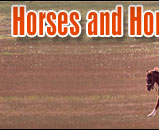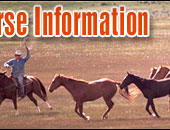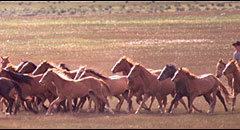 |
   |
|
|
|
You are here: Horses > Horse care > Working around horses safely |
How to Properly Work Around Horses
Many activities take place around horses and some clearly come across as
dangerous such as riding fast without a saddle and jumping obstacles. However,
did you know that both of these options are actually safer for a horse owner
than activities such as grooming with a brush which take place on the ground
near one of the horses.
|
|
|
Statistics have shown that more injuries occur when an
individual is on the ground rather than mounting on the
horse, speed and height are not the only things that can
cause injury around a horse.
When you are near horses you should always wear a helmet to
stay safe and when you are feeding, leading or grooming a
horse it is very important to remain alert. Keep the
shortest distance possible between you and the horse when
you are on the ground. Keep the horse on a short rein and
stay right up by their head so they wonít be able to |
turn and bite you. Horses have a lot of room between their
shoulder and head which makes it easy for them to turn
quickly and bite you.
While this may sound odd since you may think being father
away from a horse is safer, however the full effect of a
horses kick will be felt if you are farther away. Rather
when you are close you wonít feel much of the impact. For
the best safety you should follow all of the following tips
when working with a horse on the ground.
It is important that the horse knows where you are at, at
all times and is aware of when you are approaching them.
Start at the front and work towards the back when you are
grooming a horse. Know the horseís ticklish areas and keep a
hand in constant contact with the horse such as the flank
area. If you tickle the horse they are more likely to kick
you. Keep the fence in between the horse and yourself during
feeding. Never place a horse between you and the exit when
you are doing any work in the barn.
Soothingly talk to the horse while doing any work. Start
early with a horse and donít begin any bad habits. This
means no feeding out of your hand or foods such as sugar
when they are young. Start having the horse around people
when it is young and it is better to start them out early
with exposure to distractions of different types such as
flags flying and loud music playing nearby.
It is important to be firm but you should never mistreat an
animal. Treat the horse with respect and remember that it is
in their nature to try and be free. Never wrap a lead around
your wrist when you are leading a horse. To detect a horseís
mood you should watch their eyes and ears. If you notice
signs that they are going to have problems such as the ears
going back, the horse starts chomping at the bit or prancing
around then try and calm the horse down by talking to it and
reassuring it. When working with a horse never make any
sudden movements and if they like, touch or rub them on
their neck. Remain calm yourself and make sure the horse
knows itís not alone since it can pick up quickly and easily
on your moods. However, you should always make sure you show
the horse that you are in control by being firm, just not
too firm.

|
Read the next horse care article on Wounds and Minor Injury Care. |
|
|
|
|
 |
|
|
 |
 |
  
Visit Equestrian Cupid now.
The best and largest equestrian club for meeting the other half for friendship and marriage
|
|
 |
|
|
|
Horse Education
|
|
|
|
|
Horse Information Topics
|
|
|
|
|
|
|
|
Horse Business Owners
|
| |
Advertise with Us
Have your horse products or services exposed to over 27,000 of our monthly visitors.
|
|
|
|
|
|